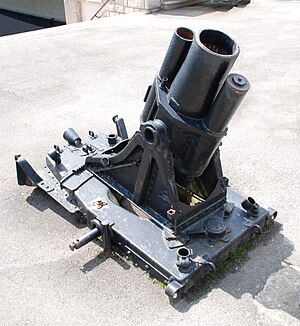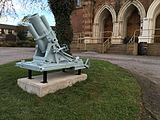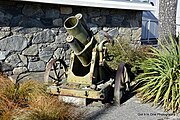17 cm mittlerer Minenwerfer
| 17 cm mittlerer Minenwerfer | |
|---|---|
 17 cm Minenwerfer n/A at the Verdun Memorial, Verdun, France | |
| Type | Medium trench mortar |
| Place of origin | German Empire |
| Service history | |
| In service | 1913–1918 |
| Used by | |
| Wars | World War I |
| Production history | |
| Designer | Rheinmetall |
| Manufacturer | Rheinmetall |
| Produced | 1913–1918 |
| No. built | approx. 2361 |
| Variants | 17 cm mMW n/A |
| Specifications | |
| Mass | 483 kg (1,065 lbs) |
| Barrel length | a/A: 64.6 cm (2 ft 1 in) L/3.8 n/A: 76.5 cm (2 ft 6 in) L/4.5 |
| Calibre | 170 mm (6.69 in) |
| Recoil | hydro-spring |
| Carriage | box trail |
| Elevation | +45° to 90° |
| Traverse | 25° |
| Rate of fire | 20 rpm |
| Muzzle velocity | 200 m/s (656 ft/s) |
| Effective firing range | 300 m (325 yards) |
| Maximum firing range | 1,600 meters (1,700 yd) |
| Sights | panoramic |
The 17 cm mittlerer Minenwerfer (17 cm mMW) was a mortar used by Germany in World War I.
Development and use
The weapon was developed for use by engineer troops after the
A new version of the weapon, with a longer barrel, was put into production at some point during the war. It was called the 17 cm mMW n/A (neuer Art) or 'new pattern', while the older model was termed the a/A (alter Art) or 'old pattern'.
In action the mMW was emplaced in a pit, after its wheels were removed, not less than 1.5 meters deep to protect it and its crew. It could be towed short distances by four men or carried by 17. Despite its extremely short range, the mMW proved to be very effective at destroying bunkers and other field fortifications. Consequently, its numbers went from 116 in service when the war broke out to some 2,361 in 1918.[2]
Two pieces of 17 cm mMW was also used by SS Heimwehr Danzig troops during the invasion of Poland.[3]
Surviving examples
- The Central Museum of The Royal Regiment of Canadian Artillery, Shilo, Manitoba
- At the Australian War Memorial, Canberra
- Also in Auburn, Massachusetts, an early short barrel model survives at the American Legion Hall
- a/A (1917 Rh.MF. Nr.5763) at the Queensland Museum], Brisbane
- n/A (1917 Sächsische Maschinen Fabrik Nr 5184) at the Campbeltown Heritage Centre, Scotland
- 4980 outside the District Council Service Center, Roxburgh, Otago New Zealand.[4][5]
- Wilbur Avenue, Cranston, Rhode Island
- Memorial Hall, Monson, Massachusetts
- Falls Park, Pendleton, Indiana USA
- Stavely Centennial Park in Stavely, Alberta has a short-barreled version (serial number 1972) of the mortar on display along with a Spandau machine gun.[6]
- The Vytautas the Great War Museum https://www.vdkaromuziejus.lt/en/
- Royal Canadian Legion Branch #15 Harbour_Grace[7]
See also
Photo Gallery
-
An early short barreled version on its carriage
-
The a/A model in transport mode, with wheels attached
-
The n/A model (with long barrel), at the Australian War Memorial, Canberra
-
1917 a/A mMW Nr.5753 at the Queensland Museum, Brisbane
-
The 1917 n/A model Minenwerfer in the grounds of Campbeltown Heritage Centre, Scotland
-
Rheinmetall 17 cm mortar captured by the 2nd Canterbury Infantry Bn on 2 August 1918 as a memorial at the Roxburgh Council Building, New Zealand
-
A diagram of a 17 cm chemical shell
-
A diagram of a 17 cm incendiary shell
Notes
- ^ Dambītis, Kārlis (2016). Latvijas armijas artilērija 1919.-1940.g.: Vieta bruņotajos spēkos, struktūra un uzdevumi [Artillery of the Latvian Army (1918–1940): structure, tasks and place in the Armed forces] (PhD thesis). University of Latvia. p. 225.
- Ft. Sill, Oklahoma.
- ISBN 8372191824.
- ^ Fox, Dr Aaron. "Distribution". Silent Sentinels. Retrieved 1 May 2017.
- ISBN 9780473255558.
- ^ "Harold A. Skaarup web pages".
- ^ "Artillery in Canada (10) Newfoundland and Labrador: Happy Valley, Hour Buffet, Grace, and Main, Hearts Content, Hearts Delight, Holyrood, la Poile, Mortier, Paradise, Port Rexton, Seal Cove, Spaniard's Bay, St. Georges, Tilting, Trepassey, and Trinity". Artillery in Canada (10) Newfoundland and Labrador: Happy Valley, Hour Buffet, Grace, and Main, Hearts Content, Hearts Delight, Holyrood, La Poile, Mortier, Paradise, Port Rexton, Seal Cove, Spaniard's Bay, St. Georges, Tilting, Trepassey, and Trinity. Retrieved 12 June 2023.
References
- Jäger, Herbert. (2001). German Artillery of World War One. Ramsbury, Marlborough, Wiltshire: Crowood Press. ISBN 1-86126-403-8.
External links








